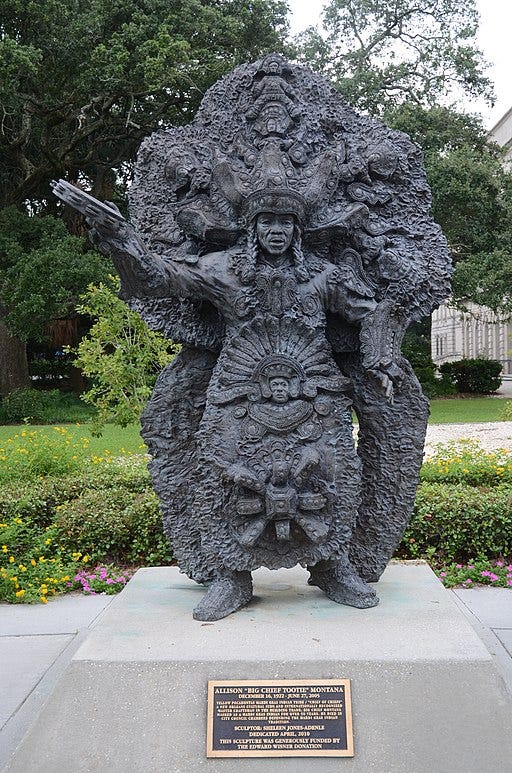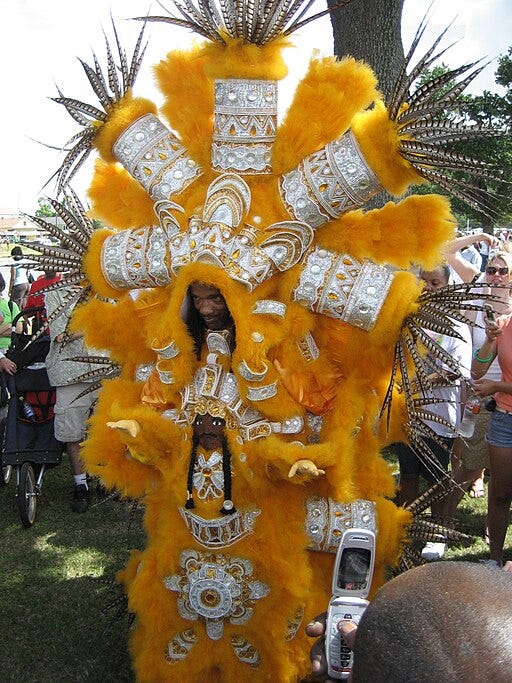Last week, I told my story of meeting Big Chief Darryl Montana and my introduction to the culture of New Orleans’ Black Masking Indians. Here is a brief summation of their history and a more detailed introduction to Darryl’s father, Tootie Montana, who was highly influential in developing the tradition in the second half of the twentieth century. I hope you enjoy it.
“The Mardi Gras Indians are called folk artists essentially because they are self-taught, non-institution sponsored, seemingly craft-centered artisans. Do we understand them by focusing on their hand-sewn suits or on their rituals, the skill of a particular chief at sewing, singing, or dancing—can any part be comprehended without some feel for the whole?” - Kalamu Ya Salaam
Becate Batiste was a plasterer who lived in the 7th ward and served as the Big Chief of the Creole Wild West Indians in the 1880s and 1890s. They were the first known group of Black Masking Indians in New Orleans. While the history of African descendants dressing in Native American-themed costumes is widespread in Caribbean Carnival, with distinct variations in Trinidad, Bahia, and Cuba, as well as Christmas maskers in Jamaica, St. Kitts, and the Dominican Republic, the timing of its appearance in New Orleans’ Carnival celebration is significant. They emerged following the abrupt end of the Reconstruction era in the United States and the dashed hopes of redress for the injustices of slavery and its devastating social, cultural, and economic impacts. During this time, people of color were outlawed from participating in the city's annual Mardi Gras celebration. The tradition of Black Masking Indians began as a form of protest within the black community in Jim Crow-era New Orleans, with these men paying homage to Native Americans who, at that time, were taking up arms against American insurgence on their land and culture.
The Black Masking Indians have never invited mass participation like the popular “krewes” hosting float-laden parades through the French Quarter and business district. They have remained a semi-underground phenomenon with small, independent groups and no central organization. Mardi Gras Day plays like a mock war game through neighborhood streets without a publicized map. The tribes use secret routes to avoid being surrounded by other tribes. Along the way, they might encounter another tribe. In the early twentieth century, this led to actual fighting, but now, it is a stage for competitive singing, dancing, and display. This evolution from combat to boasting competition is an underlying aspect of how this living tradition has adapted and changed.
As in Europe, Carnival in New Orleans in the nineteenth and early twentieth centuries often exposed social conflicts. Because the celebration allows for the expression of hostility, many stories from that time depict violence. During the early part of the twentieth century, tension built up between different Indian gangs over the previous year and led to fights at a place uptown known as the “Battlefield.” These conflicts resulted in injuries and even death. In the latter half of the twentieth century, the competition shifted to focus on music, dance, and spectacle, with different tribes trying to outdo one another. This artistic rivalry has long been a part of other Caribbean festivals. Today, much of the competitive spirit is channeled into creating elaborate suits, and gang conflict is highly ritualized. While they may seem to be celebrating discord by challenging each other as rivals, the tradition has come to represent the opposite—a symbol of African American unity.
Tootie Montana (1922-2005) - A Hero’s Journey

A grand-nephew of Becate Batiste, Tootie Montana is generally credited as the primary figure in inspiring the change from physical to aesthetic combat amongst tribes of Black Masking Indians in New Orleans. He worked as a lathe operator, and his spectacular three-dimensionally constructed suits came from his knowledge of the building trades and his legendary work ethic. “Pay me ten dollars, and I’ll give you twenty dollars of work.” He constructed the frames for arches on some of the city’s most prominent structures.
Allison Marcel Montana was born on December 16th, 1922, to a Creole family in New Orleans, living at 1313 St. Anthony Street between Dorgenois and Morais—and grew up in a house with his mother, siblings, grandparents, cousins, and in-laws. "It was twenty-one of us living in the house. During those times, people didn't worry about living rooms. There was six bedrooms and three kitchens." His mother’s beloved first cousin, Bea, nicknamed him Tootie when he was a young boy.
Tootie's parents separated when he was very young. His father, Alfred Montana, was a sign painter and sometimes worked as a baker. Tootie did not know him well, but Alfred made a suit for his older brother Edward when he was six. The following year, Alfred made a new red suit for Edward, and Tootie became the proud wearer of the pink suit his brother had worn the year before (Edward was his second chief until he passed on 12/31/1994. Edward’s son David—Darryl’s cousin—is chief of the Washitaw nation). Wearing this suit and seeing the Black Masking Indian culture up close created a strong bond between Tootie and his father that rekindled years later. Tootie also recalled being part of a skeleton gang in his early teens. About fifteen members would dress in black and white painted bones on large sculptured heads made of enamel-painted cheesecloth stretched over wire frames.
Tootie did not embrace his "suiting" heritage until he returned from working in shipyards in California during World War II. When he learned that Alfred Montana would be the chief of a gang in the eighth ward, he went to his father's house just three weeks before Mardi Gras and demanded that he make him a suit so that he could join the 8th Ward Hunters as they made their 1947 trek through the city. The following year was Alfred Montana’s last, but Tootie was already on his way to becoming an icon. There was only one year between 1947 and 2005 (1986) that he did not make a new suit.
In 1949, Tootie began creating unique designs, including full-length crowns and intricate beadwork. His use of "abstract geometric, three-dimensional figures in addition to representational designs" introduced a new “downtown” suit style that transformed how people dressed up for Carnival. His initial suit was so stunning that Robert Guidry, who had taken over as chief after Tootie's father, refused to mask as Big Chief again. “Whispered in my ear, he said, 'Man look, you're prettier than I am.' He said, 'You go ahead and be the chief.' I said, 'No, you're chief this year.’” From the start, Tootie was a transformational figure in the Black Masking Indian world—both aesthetically and culturally. He formed his group, the Monogram Hunters, the following year. Seven years later, he changed the group’s name to Yellow Pocahontas. He served as chief until 1997 when he passed it to Darryl.
"A lot of people think that my father showed me how to make Indian costumes, but he never showed me anything. As a matter of fact, he was surprised. He didn't want to see me out do him either. He had the history for having a pretty crown. If you are really into this like my daddy was and like I am, then you're really proud. I learned by making mistakes.”
Tootie was deeply upset by the fighting between tribes, which he believed disrespected the culture their ancestors had struggled to pass on. Many nights after Carnival, he would return home in a battered suit, covered in blood and bruises from the night's events. Tootie spoke out against Indian gang violence and turned to music and dance as a way to emphasize competitive showmanship. In the words of his widow, Joyce Montana, he was the first to say, "Stop fighting with your guns, and begin fighting with your suits and minds."
He believed that if an Indian spent months working on an elaborate suit, they would avoid violence to prevent tarnishing it. "I'm the one who changed it from fighting with the guns to fighting with suits. Everybody in the city, even the rag men, in their mind they think they can outdo me. They be sewing to beat me and they get fooled every time.” The Yellow Pocahontas became so intimidating that other tribes ceased to challenge them, and levels of conflict decreased. Tootie's strong work ethic, competitive spirit, and pride fended off the most formidable rivals who sought to surpass his remarkable artistry. “Kill them dead with a needle and thread.”
Tootie’s most essential traits were evident immediately after he became chief. His leadership skills quickly gained the trust of his peers. "You see, not everyone can be a chief. Those who follow you need to see you as a superior in order to respect you and follow your lead. They must have that sentiment." His overwhelming dedication, creativity, and skill in fabricating suits transformed the culture.
Trailer for Tootie's Last Suit, a documentary about New Orleans Black Indian culture and the life, death, and art of New Orleans icon Chief Tootie Montana as he makes one last Mardi Gras suit.
Tootie maintained that his first ten years of masking Indian were "for myself. The rest of the time, those other forty years were for the people. After you do it for so many years and you get involved and you get to be the people's person, you have a lot of feeling for the people. They make you do a lot of things. Right now, when I'm making a suit, I be saying, 'Boy, wait until the people see this.' That's what I sew for."
Because of his family history, Tootie Montana was the leading authority on Indian singing, dancing, and drumming. Few matched his knowledge of the traditions surrounding chants and songs. In 1987, he received a fellowship as a Master Traditional Artist from the Folk Art Program of the National Endowment for the Arts in Washington, D. C. He was honored by President Reagan, the Smithsonian, and the New Orleans Museum of Art. The suits may be the most striking aspect of the tradition, but there is a more profound display than costuming at work. Tootie was the strongest proponent of Black Masking Indian values—enduringly spiritual, anti-commercial, and community-based.
The love and respect paid to him during his life and after by all the people in New Orleans is a testament to his imaginative design, impeccable craftsmanship, and genuine leadership for over fifty years. Often called the chief of chiefs, Tootie Montana addressed the New Orleans city council regarding police harassment and misconduct at the 2005 Super Sunday/St—Joseph’s Night celebration held in his honor. He concluded by pleading, “I want this to stop!” They were to be his last words—he suffered a fatal heart attack and fell to the ground, where his son, Darryl Montana, rushed to his side. Big Chief Tootie, as a well-known Indian song proclaims, “died on the battlefield,” fighting for the Indians, refusing to bow down.

Tootie’s vast influence on the tradition is deep and wide. Chiefs who formed other tribes that started as members of the Yellow Pocahontas include Joe Pete Adams of the Seminole Indians, Larry Bannock of the Golden Star Hunters, Ferdinand Bigard of the Cheyenne Hunters, Monk Boudreaux of the Golden Eagles, "Lil" Walter Cook of the Creole Wild West, Emile "Bo" Dollis of the Wild Magnolias, Lawrence Fletcher and later Jake Million of the White Eagles, Victor Harris of the Spirit of Fi-Ya-Ya, Donald Harrison, Sr. of the Guardians of the Flame, George Landry, known as Big Chief Jolley, of the Tchoupitoulas, Percy "Chief Pete" Lewis of the Black Eagles and Charles Taylor of the Yellow Jackets. All are legendary for keeping this tradition alive and vibrant.






